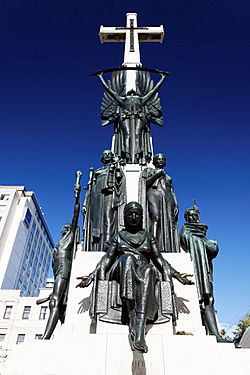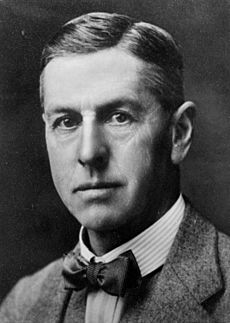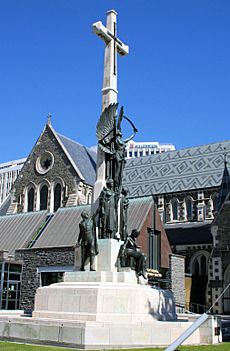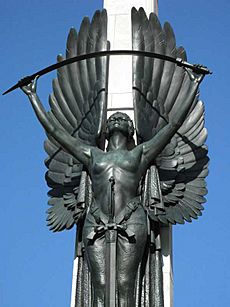Citizens' War Memorial facts for kids
Quick facts for kids Citizens' War Memorial |
|
|---|---|
| New Zealand | |

Citizens' War Memorial in Christchurch's Cathedral Square
|
|
| For New Zealand dead of World War I | |
| Unveiled | 9 June 1937 |
| Location | 43°31′50″S 172°38′13″E / 43.5306°S 172.6369°E |
| Designed by | William Trethewey (stonemason) George Hart (architect) |
|
In grateful remembrance of the sons and daughters of Canterbury who fell in the Great War 1914–1918 Give peace in our time o Lord.
|
|
The Citizens' War Memorial in Cathedral Square, Christchurch, is a special monument. It remembers the New Zealand soldiers who died in World War I. You can find it just north of ChristChurch Cathedral.
For many years, the main Anzac Day service was held here. This changed after the February 2011 earthquake. The memorial is also a very important historic building, listed as a Category I heritage structure. In 2020, plans were made to move the memorial from its spot and put it into storage.
Contents
Where is the Citizens' War Memorial?
The Citizens' War Memorial is in Cathedral Square in Christchurch. It stands right next to ChristChurch Cathedral. The land it sits on belongs to the Anglican Church. You can even see it from the heritage tram that goes around the Cathedral.
How the Citizens' War Memorial Was Built
After World War I ended, people had many ideas for a war memorial. George Gould was a successful businessman. He suggested building a tall column across from ChristChurch Cathedral. By 1920, his idea was one of the top three choices.
Another idea, the Bridge of Remembrance, was built first in 1924. But the Christchurch City Council didn't like Gould's idea for Cathedral Square. They thought the large Cathedral would make the memorial look too small. They also felt the busy Square wasn't a good place for quiet reflection.
In 1933, a statue of John Robert Godley was moved from its spot near the Cathedral. This opened up the perfect space. George Gould quickly suggested this empty site for the memorial. The Anglican Church, which owned the land, agreed. But they had one condition: a cross had to be part of the design. Gould wanted the memorial to represent "peace, not war."
The memorial was designed to show peace and high ideals. The architect George Hart and sculptor William Trethewey worked together. Trethewey's son said his father sketched the idea during lunch. He took it to Hart, and they created the final design.
The design was approved in 1933. Trethewey then made clay models of the figures. These models were sent to a foundry in London to be cast in bronze. Trethewey even went to London to watch the bronze figures being made.
The Citizens' War Memorial was officially revealed on 9 June 1937. Colonel S C P Nicholls unveiled it, and Archbishop Julius led the service. Many people believe it is one of the best public monuments in New Zealand.
Anzac Day Services and the Memorial's Future
Every year, thousands of people gather at the memorial for Anzac Day services. This is a day to remember those who served and died in wars.
After the earthquake in February 2011, the city center was closed off. So, the Anzac Day service moved to Hagley Park. In later years, it moved to Cranmer Square.
In 2017, some groups asked for the memorial to be moved to Cranmer Square. This was because the Cathedral was being repaired, and people couldn't easily get to the memorial. In 2020, it was confirmed that the memorial needs to be moved for the Cathedral's restoration. It will be put into storage unless a new permanent home is found.
What the Memorial Looks Like
The bronze memorial stands 16 meters (about 52 feet) tall. The bronze figures were made in London. They show a classic, ideal style. The figures represent important ideas like Youth, Sacrifice, Justice, Valour, and Peace.
Sculptor William Trethewey based these figures on his own family and friends. For example, his daughter Pauline and his worker Bob Hampton helped model for the figures. There is also a religious figure of Saint George.
At the bottom of the memorial, there is an important message: In grateful remembrance of the sons and daughters of Canterbury who fell in the Great War 1914–1918 Give peace in our time o Lord.
Heritage Status
The Citizens' War Memorial is listed as a Category I heritage structure by Heritage New Zealand. This means it is a place of special historical importance. It was first listed in 1984, and its category was updated in 1995.
Images for kids








